
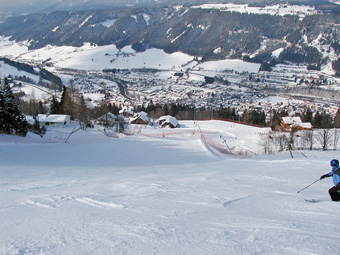
|
|
|
Skiing down the black World Cup downhill run in Schladming is a thrill rarely experienced by ordinary skiers. Its huge drops gave me a taste of what Bode Miller must feel like as he’s screaming down the mountain. The elaborate netting system that lines the side of the piste accentuates the course’s challenge, but also offers some comfort for amateurs like me as we hurdle ourselves down the run as fast as we dare to ski.
Schladming is one of the 28 resorts of the Ski Amade Alliance near Salzburg, Austria. Although Ski Amade contains 260 lifts and 865 kilometers of marked trails, most North American skies have never heard of the place. When Americans travel to Europe to ski, they inevitably hit one of the big centers in France or Switzerland, ignoring the less crowded, less expensive but equally fine skiing in Austria.
Austria, however, has some distinct advantages for the East Coast skier. First, there are direct flights from Washington and other East Coast air major hubs to Vienna, which is only three hours by car or train from the Dachstein Tauern. Second, even with the low dollar, skiing in Austria is still very reasonable. A one-day Ski Amade ticket is just $38 and one can easily find rooms for less than $100 a night. For an extra $12 or so per person, most hotels will also provide half pension: a multi course dinner in addition to the standard breakfast buffet.
The drive from my in-laws’ residence in central Slovakia to the Styrian Alps proved longer than expected due to heavy snow. By the time we got to Vienna, it was snowing too hard to continue, so in the suburb of Pischelsdorf I pulled into a small place called Gasthof Fede “Zum Schlachthof.” For $72, my wife and I got a huge room with a terrace, two full dinners, and breakfast. Austria has some of the highest accommodation standards in Europe - even the most modest guesthouse will be impeccably clean and comfortable.
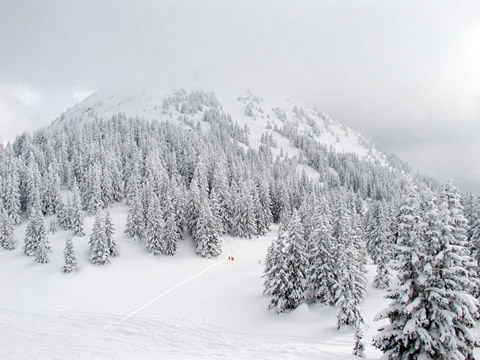
|
|
|
We arrived in the Dachstein Tauern and managed to be on the slopes by noon. High-speed lifts and low crowds allowed us to bag 20,000 vertical feet of skiing in just four hours - more than a day’s worth of skiing at West Virginia’s Timberline Resort! The Dachstein Tauern consists of four mountains interconnected by lifts and another four areas, including the Dachstein glacier, accessible by ski bus. The hubs of the region are towns of Schladming and Haus. The mountains that serve these towns, Planai and Hauser Kaibling, have the best lift systems in the region and connect by lifts to each other and two additional areas: Hochwurzen and Reiteralm. Together, these four areas are called the “4-Berge-Skischaukel.”
Have I confused you yet? Well, it’s not as confusing as one might think because all four mountains are very similar. All possess approximately 1,000 meters (3,000 feet) of vertical and contain numerous, broad, tree-lined slopes. Many people envision the Alps as treeless, craggy peaks like Mont Blanc, but the Styrian Alps possess numerous Spruce-covered peaks with decent snow coverage from 750 meters (2,460 feet) to 1,850 meters (6,069 feet) of altitude. As one moves east in Europe, the climate becomes more continental, allowing snow to hold at lower elevations.
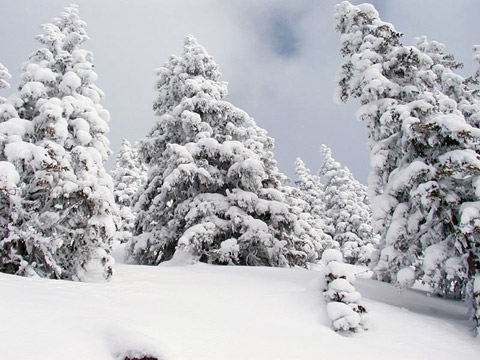
|
|
|
Trees were the big attraction of the Dachstein Tauern for my wife, who not only finds them visually appealing but appreciates their ability to shelter a skier from wind and provide contrast in the flat light conditions so prevalent in the Alps. Trees make the Dachstein Tauern a “kinder, gentler” Alpine region than the above-treeline moonscapes of the Arlberg or the Savoy.
We stayed at a lovely four-star hotel called Landidyll Hartweger in Weissenbach, a hamlet not far from the Hauser Kaibling gondola station. The next day, we skied with Carina Hartweger from the local Tourist Office. Carina, originally from Sweden, settled in Weissenbach after marrying an Austrian. Carina proved a fantastic skier and a knowledgeable insider. For our first run, she took us to lesser-known section of trails and high-speed lifts owned and maintained by Helmut Höflehner, the winner of the 1985 and 1990 men’s downhill World Cup. Helmut, a modest guy who often fills in as a lifty, designed one of the most enticing slopes on Hauser-Kaibling - the northeast facing number three run. This run is rated blue (beginner in Europe) but it will satisfy most experts because of its double fall lines and interesting dips.
On the lift riding back up the mountain, Carina waved to her teenage son, a student at the prestigious local ski academy. Rather than waving back, the boy headed down one of the steepest slopes on the hill (the women’s World Cup downhill run), caught some big air off a kicker, and crossed his skis a la Seth Morrison. Mom did not look pleased but a lot of people on the lift, including myself, cheered.
Although one can spend a week in the Dachstein Tauern and never ski the same slope twice, Carina advised us not to waste too much time moving from one mountain to the next but instead focus on trails we enjoyed. With all the new snow, my wife and I enjoyed the higher elevation powder meadow between Hauser Kaibling and Planai. We also enjoyed the Women’s downhill racing course at Hauser Kaibling. In all my trips to the Alps, I have rarely experienced such uncrowded slopes as those I found in the Dachstein Tauern. Daily fresh snow enhanced the experience, and I was pleased to learn from Carina that the area has one of the best snowmaking systems in the Alps and intends to expand it even further in the future.
“Pig and potatoes” is the way my wife occasionally describes Central European food. To some degree, she’s correct. The cuisine contains lots of pork schnitzels and various forms of potatoes, but it’s also known for its tortes, pastries, fresh produce, wine, and beer. Every day between four and six, the Landidyll Hartweger hotel puts out a huge tray of pastries, cakes, fruit, cheese, and bread. To wash it down, the hotel serves various herbal teas made from its garden or for an extra price, Styrian wine or beer. An hour later, the hotel’s multi-course dinner began. While I often ate more food in Austria than I normally eat at home, the skiing burned most of it off. I also ate very small lunches - typically just a bowl of soup or a single frankfurter. Sensitive to those not wishing to gain pounds, Landidyll Hartweger serves vegetarian and light fish or chicken entrees nearly every day in addition to typical Austrian fare. Their buffet system also allows one to eat as much or little as one pleases, and if none of the entrees prove appealing, there’s always an ample salad bar.
On our last day in the region, we opted to ski Reiteralm, one of the smaller mountains of the 4-Berge mountains. By small, I don’t mean less vertical but fewer trails and less modern lifts. As in America, Saturday is a big ski day in Europe, so we hoped to avoid some of the crowds by heading to Reiteralm and skiing trails serviced by Pomas rather than chairs. We were not disappointed. Saturday turned out to be a blue bird: sun, fresh powder, and moderate temperatures. Furthermore, as hoped, Reiteralm’s slopes were for the most part empty. Nothing pleases me more than to be alone on top of a big mountain with perfect blue sky and fresh snow. On a lark, we transferred by gondola to Hochwurzen and found more people but equally superb snow and terrain.
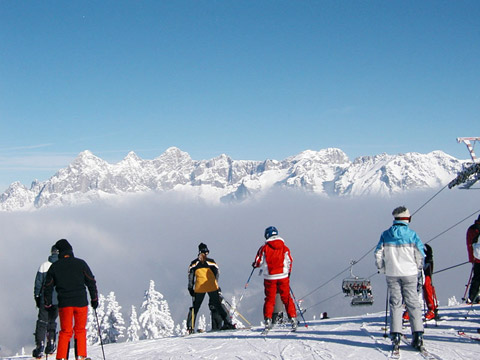
|
|
|
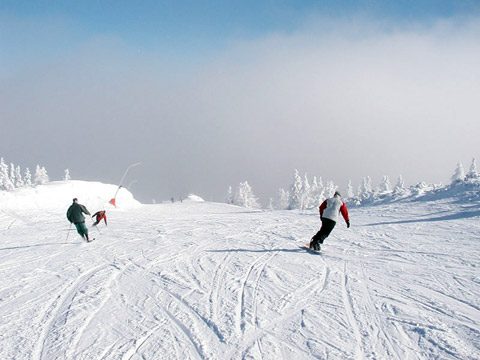
|
|
|
For my wife, the Dachstein Tauern lived up to all her expectations: big vertical, tree-lined slopes, modern lifts, and good snow. I also enjoyed the area and found some excellent steep runs. However, the area is not for everyone. Those in search of above-treeline terrain, rocky couloirs, and off-piste will be disappointed. Although nearly everyone does it, skiing out of bounds in the trees is officially forbidden and in-bounds gladed terrain can only be found in a few high elevation areas. To attract more experts and extreme skiers, the managers of these impressive mountains may wish to develop more gladed terrain in the mid-mountain areas of the resorts. If maintained properly, the natural gladed terrain in the Dachstein Tauern could transform these mountains into a world-class proving ground for the Mad River Glen type who wants to “ski good or eat wood.”
(Photos provided by John Sherwood.)
John Sherwood is a columnist for DCSki. When he's not hiking, biking, or skiing, he works as an author of books on military history.
